Smith Hickenlooper
Smith Hickenlooper | |
|---|---|
 | |
| Judge of the United States Court of Appeals for the Sixth Circuit | |
| In office December 17, 1928 – December 22, 1933 | |
| Appointed by | Calvin Coolidge |
| Preceded by | Maurice H. Donahue |
| Succeeded by | Florence E. Allen |
| Judge of the United States District Court for the Southern District of Ohio | |
| In office March 3, 1923 – January 7, 1929 | |
| Appointed by | Warren G. Harding |
| Preceded by | John Weld Peck |
| Succeeded by | Robert Reasoner Nevin |
| Personal details | |
| Born | February 13, 1880 Cincinnati, Ohio, U.S. |
| Died | December 22, 1933 (aged 53) Cincinnati, Ohio, U.S. |
| Resting place | Spring Grove Cemetery Cincinnati, Ohio, U.S. |
| Spouse | Anna Bailey Wright |
| Parent(s) | Andrew Hickenlooper Maria Lloyd Smith Hickenlooper |
| Relatives | John Hickenlooper (paternal grandson) George Hickenlooper (paternal grandson) |
| Education | University of Cincinnati (BA) Harvard University (LLB) |
| Military service | |
| Branch/service | |
| Battles/wars | World War I |
Smith Hickenlooper (February 13, 1880 – December 22, 1933) was an American attorney and jurist who served as a United States circuit judge of the United States Court of Appeals for the Sixth Circuit. He was previously a United States district judge of the United States District Court for the Southern District of Ohio.
Early life and education
[edit]Born in Cincinnati, Ohio, Hickenlooper was the son of Maria Lloyd (Smith) and Andrew Hickenlooper, who was a civil engineer, politician, industrialist, and a Union Army lieutenant colonel.[1][2] He graduated from Woodward High School,[1] and received a Bachelor of Arts degree from the University of Cincinnati in 1901 and a Bachelor of Laws from Harvard Law School in 1904.[3] While at the University of Cincinnati, Smith, along with his brother Andrew, founded Sigma Sigma in 1898.
Career
[edit]He was in private practice in Cincinnati from 1904 to 1918, also serving as a member of the Cincinnati Board of Education from 1908 to 1909, and as a member of the board of directors of the University of Cincinnati from 1910 to 1916.[4] He was an assistant prosecuting attorney of Hamilton County, Ohio from 1916 to 1918, but left to join the United States Army during World War I, serving as a private in a field artillery unit in 1918. Hickenlooper returned to Ohio before the end of 1918 and served as a judge on the Superior Court of Cincinnati from 1918 to 1923.[3]
Federal judicial service
[edit]Hickenlooper was nominated by President Warren G. Harding on March 3, 1923, to a seat on the United States District Court for the Southern District of Ohio vacated by Judge John Weld Peck. He was confirmed by the United States Senate on March 3, 1923, and received his commission the same day. His service terminated on January 7, 1929, due to his elevation to the Sixth Circuit.[5]
Hickenlooper was nominated by President Calvin Coolidge on December 6, 1928, to a seat on the United States Court of Appeals for the Sixth Circuit vacated by Judge Maurice H. Donahue. He was confirmed by the Senate on December 17, 1928, and received his commission the same day. His service terminated on December 22, 1933, due to his death in Cincinnati.[5][6] He was interred in Spring Grove Cemetery in Cincinnati.[6]
Personal life
[edit]Hickenlooper married Anna Bailey Wright of Cincinnati on October 18, 1910.[1][4] His grandson is U.S. Senator and former governor John Hickenlooper. He is also related to pianist Olga Samaroff, (née Lucy Mary Olga Agnes Hickenlooper).[7]
References
[edit]- ^ a b c Goss, Charles Frederic (1912). Cincinnati, the Queen City, 1788-1912. Vol. 3. Cincinnati: S J Clarke Publishing Company. pp. 374, 375.
- ^ "The National Cyclopaedia of American Biography: Being the History of the United States as Illustrated in the Lives of the Founders, Builders, and Defenders of the Republic, and of the Men and Women who are Doing the Work and Moulding the Thought of the Present Time". 1967.
- ^ a b "Judge Hickenlooper Dies Attending Dance". The New York Times. December 23, 1933. p. 15. Retrieved April 2, 2015.
- ^ a b Galbreath, Charles Burleigh (1925). History of Ohio. Vol. IV. Chicago: The American Historical Society. p. 389. ISBN 978-0-7812-5367-3.
- ^ a b Smith Hickenlooper at the Biographical Directory of Federal Judges, a publication of the Federal Judicial Center.
- ^ a b Smith Hickenlooper Sr. at Find a Grave
- ^ Hickenlooper, John; Potter, Maximillian (2016). The Opposite of Woe, My Life in Beer and Politics. New York: Penguin Press. pp. 37, 112.
Sources
[edit]- Smith Hickenlooper at the Biographical Directory of Federal Judges, a publication of the Federal Judicial Center.
- Smith Hickenlooper Sr. at Find a Grave
- 1880 births
- 1933 deaths
- Ohio state court judges
- Judges of the United States District Court for the Southern District of Ohio
- United States district court judges appointed by Warren G. Harding
- Judges of the Superior Court of Cincinnati
- Judges of the United States Court of Appeals for the Sixth Circuit
- United States court of appeals judges appointed by Calvin Coolidge
- 20th-century American judges
- 20th-century American lawyers
- Burials at Spring Grove Cemetery
- University of Cincinnati trustees
- Lawyers from Cincinnati
- University of Cincinnati alumni
- Harvard Law School alumni
- United States Army personnel of World War I
- Ohio lawyers
- United States Army soldiers
- Hickenlooper family
- Woodward High School (Cincinnati, Ohio) alumni
